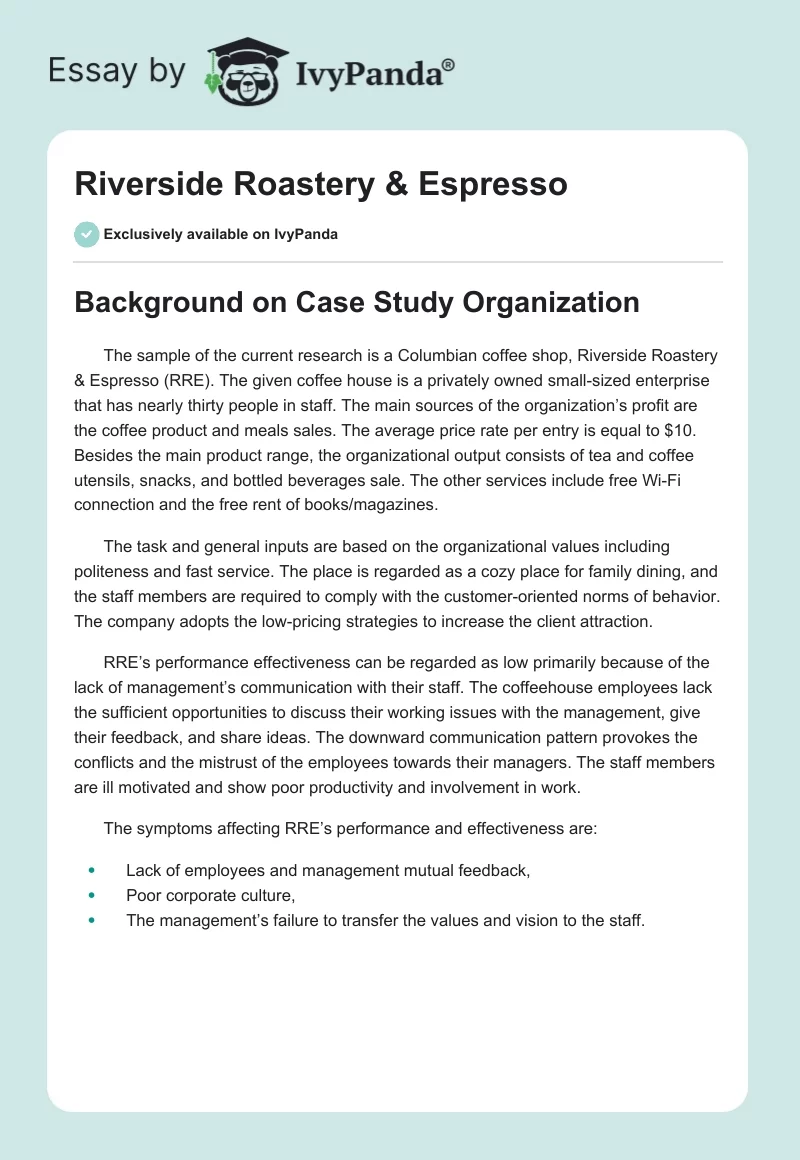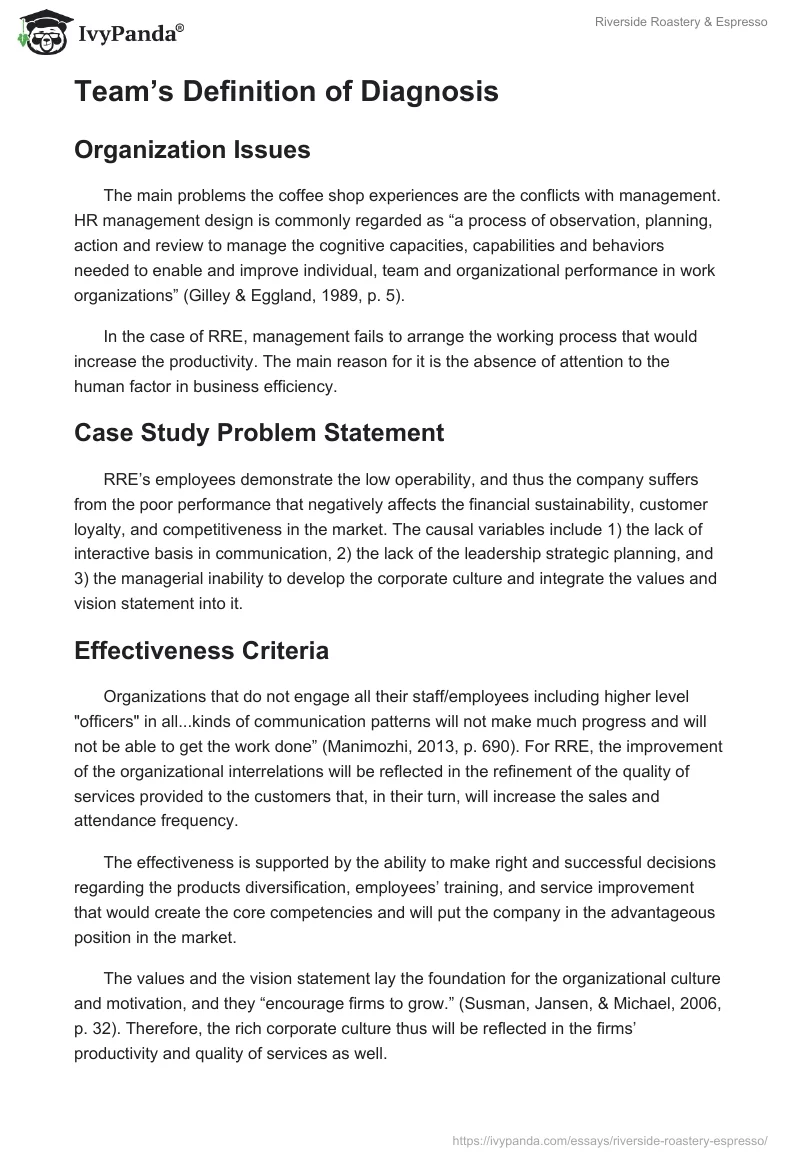Background on Case Study Organization
The sample of the current research is a Columbian coffee shop, Riverside Roastery & Espresso (RRE). The given coffee house is a privately owned small-sized enterprise that has nearly thirty people in staff. The main sources of the organization’s profit are the coffee product and meals sales. The average price rate per entry is equal to $10. Besides the main product range, the organizational output consists of tea and coffee utensils, snacks, and bottled beverages sale. The other services include free Wi-Fi connection and the free rent of books/magazines.
The task and general inputs are based on the organizational values including politeness and fast service. The place is regarded as a cozy place for family dining, and the staff members are required to comply with the customer-oriented norms of behavior. The company adopts the low-pricing strategies to increase the client attraction.
RRE’s performance effectiveness can be regarded as low primarily because of the lack of management’s communication with their staff. The coffeehouse employees lack the sufficient opportunities to discuss their working issues with the management, give their feedback, and share ideas. The downward communication pattern provokes the conflicts and the mistrust of the employees towards their managers. The staff members are ill motivated and show poor productivity and involvement in work.
The symptoms affecting RRE’s performance and effectiveness are:
- Lack of employees and management mutual feedback,
- Poor corporate culture,
- The management’s failure to transfer the values and vision to the staff.
Team’s Definition of Diagnosis
Organization Issues
The main problems the coffee shop experiences are the conflicts with management. HR management design is commonly regarded as “a process of observation, planning, action and review to manage the cognitive capacities, capabilities and behaviors needed to enable and improve individual, team and organizational performance in work organizations” (Gilley & Eggland, 1989, p. 5).
In the case of RRE, management fails to arrange the working process that would increase the productivity. The main reason for it is the absence of attention to the human factor in business efficiency.
Case Study Problem Statement
RRE’s employees demonstrate the low operability, and thus the company suffers from the poor performance that negatively affects the financial sustainability, customer loyalty, and competitiveness in the market. The causal variables include 1) the lack of interactive basis in communication, 2) the lack of the leadership strategic planning, and 3) the managerial inability to develop the corporate culture and integrate the values and vision statement into it.
Effectiveness Criteria
Organizations that do not engage all their staff/employees including higher level “officers” in all…kinds of communication patterns will not make much progress and will not be able to get the work done” (Manimozhi, 2013, p. 690). For RRE, the improvement of the organizational interrelations will be reflected in the refinement of the quality of services provided to the customers that, in their turn, will increase the sales and attendance frequency.
The effectiveness is supported by the ability to make right and successful decisions regarding the products diversification, employees’ training, and service improvement that would create the core competencies and will put the company in the advantageous position in the market.
The values and the vision statement lay the foundation for the organizational culture and motivation, and they “encourage firms to grow.” (Susman, Jansen, & Michael, 2006, p. 32). Therefore, the rich corporate culture thus will be reflected in the firms’ productivity and quality of services as well.
Case Study Purpose Statement
The purpose of this case study is to develop research questions and identify data collection instruments to assess the causal variables of bad organizational communication, lack of the leadership strategy, and poor corporate culture to determine the best change interventions to implement.
Case Study Diagnostic Research Questions
- What pattern of the organizational communication will be able to support the best quality of the services provided to customers?
- What steps must be included in the managerial strategy that would create the product diversification and advance the competitiveness?
- What values can encourage the employees’ involvement in the working process?
Research Methodology
The identified causal variables are the main factors interfering with the coffee shop’s business efficiency. The effectiveness of operations is based on the sound and open way of interactions both with the individuals within the company and outside of it. For the motivation of the subordinates, the managers must understand the employees (Carnall & Roebuck, 2015, p. 13).
Therefore, the business conduction must be built on the principles supporting the flow of information in both downward and upward directions. The corporate culture is meant to create the collective’s cohesiveness and involvement in work. The lack of strong cultural aspect in RRE organizational culture negatively affects its output.
The methods used in the research study include the analysis of information collected by surveys and the open-ended interviews with the coffee house staff members. The data collected by interviewing is subjective in its nature (Creswell, 2014, p. 15).
However, the in-depth analysis of the data will help to measure the extent of relations between the given causal variables and the business effectiveness. The multiple-choice survey questions will allow the assessment of the connections between the effectiveness criteria, the current organizational operability, quality of service, and products.
Organization Interventions
The organizational structure design depends on the adoption of the corporate culture, values, and vision by employees and the performance of personnel depends on the degree of the motivation by the organizational values (Cummings & Worley, 2014, p. 523). The main task of managers as leaders is to inspire and encourage employees to achieve results through the efficient fulfillment of work (Pasmore, 2014, p. 4).
The RRE leaders need to create the value system and to integrate it into the corporate culture. The integration process must be supported by a sound method of interaction and communication with employees. The subordinate’s capability of giving their feedback on the operational processes and sharing their ideas regarding the organizational design and performance is crucial for the increase of the organizational productivity.
The assessment and measurement of the external environment, the recognition of urge for change and the implementation of business innovations are the principle aspects of any strategy (Burnes, 2014, p. 302). Therefore, the elaboration of the appropriate leadership and change strategy and the structural redesign can help the coffee shop to improve the productivity, increase the employees’ job satisfaction, and profitability. The strategic plan will increase the competitiveness of the company in the industry.
Diagnosis of the Organization’s Readiness for Change
The employees, managers, and the customers can be regarded as RRE’s stakeholders who would be supportive of the change. Therefore, there are no hindrances for RRE’ successful transition to change. The sound relationships with stakeholders groups maintain the business profitability, and, therefore, their benefits must be taken into account (Braica, 2013, p. 138).
The consideration of the stakeholders’ interest, i.e. low prices for the customers or the friendly working environment for the employees, benefits the company’s leaders (Yu & Fang, 2009, p. 1275). It brings larger profits, decreases the staff turnover, and increases the popularity of the place among the Columbian public.
Discussion
The development of organizational culture plays a significant role in the effectiveness of outputs. “Cultural change generally requires supporting modifications in organization structure, human resources systems, information and control systems, and management styles” (Cummings & Worley, 2014, p. 527). The introduction of the organizational values supports the implementation of business strategy in practice.
Communication is the main leadership tool for the efficiency of the organizational transition to change. Leadership is determined to guide the organization through the changes process. Therefore, leaders must show the behavior “needed to implement the business strategy and create the desired culture (skills, competencies, knowledge base)” (Pasmore, 2014, p. 3).
Through the strategic decisions and the constant communication and free, leaders engage all their subordinates in the processes of change by the constant learning, developing, and informing. The considerations of all the factors that cause the dynamic changes in the market by leaders contribute to financial sustainability, high productivity levels, and business development (Cetindamar, Phaal, & Probert, 2009, p. 237).
The company’s efforts in monitoring and determination of the stakeholders’ interests and development of the strategies based on their interests are significant. It can be considered that the stakeholders’ interests are actually taken into account if they are reflected in the organizational decision-making and actions.
When a company addresses the stakeholders’ needs, such as the high level of employees’ job satisfaction or the good quality and the reasonable prices of products provided to the customers, the corporation attains the benefits of different kind: financial profitability supported by the customers’ loyalty; the low rate of the staff turnover and high level of productivity; the business partners’ trust, etc.
The success in business depends on all the mentioned aspects: culture, strategy, and stakeholders’ interests. The consideration of the multiple effectiveness criteria will increase the probability of the positive achievement.
References
Braica, A. (2013). Fundamentals of change management. Studia Universitatis “Vasile Goldis” Arad. Seria stiinte economice, 23(4), 138-149.
Burnes, B. (2014). Managing change. Harlow, UK: Pearson Education Limited.
Carnall, C., & Roebuck, C. (2015). Strategic leadership development: Building world-class performance. New York, NY: Palgrave.
Cetindamar, D., Phaal, R., & Probert, D. (2009). Understanding technology management as a dynamic capability: A framework for technology management activities. Technovation, 29(4), 237-246.
Creswell, J. (2014). Research design: Qualitative, quantitative, and mixed methods approaches. Thousand Oaks, US: SAGE Publications.
Cummings, T., & Worley, C. (2014). Organizational development & change. Mason, OH: South-Western Cengage Learning.
Gilley, J. & Eggland, S. (1989). Principles of Human Resource Development. Reading, MA: Addison-Wesley.
Manimozhi, S. (2013). Organizational communication and reports. Language in India, 13(5), 690-695.
Pasmore, W. (2014). Developing a leadership strategy: A critical ingredient of organizational success. Web.
Susman, G., Jansen, K., & Michael, J. (2006). Innovation and change management in small and medium-sized manufacturing companies. Web.
Yu, H., & Fang, W. (2009). Relative impacts from product quality, service quality, and experience quality on customer perceived value and intention to shop for the coffee shop market. Total Quality Management, 20(11), 1273-1285.


